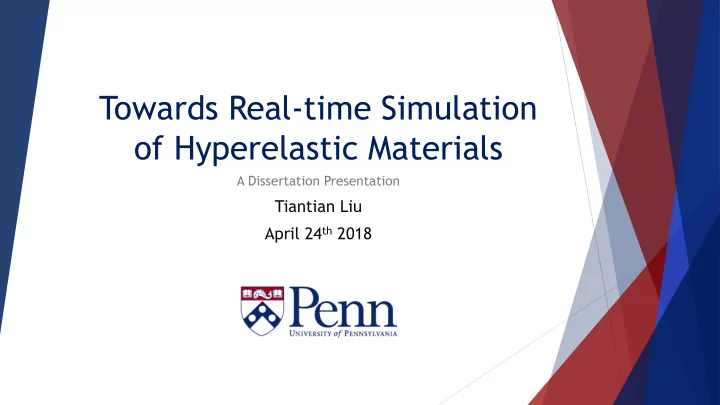

Remark: Projective Dynamics 2 𝑼 𝒚 − 𝒒 𝑘 𝐹 𝒚 = min 𝑥 𝑘 𝑯 𝒌 𝒒∈ℳ 𝑘 1 + 1 𝑦 − 𝑧 𝑈 𝑵 𝑦 − 𝑧 2 𝑢𝑠 𝒚 𝑈 𝑴𝒚 − 𝑢𝑠 𝒚 𝑈 𝑲𝒒 + 𝐷 min 2ℎ 2 𝑢𝑠 𝑦∈ℝ 𝑜×3 ,𝒒∈𝓝 Like before, 𝑵, 𝑴, 𝑲, 𝒅 does not depend on 𝒚 and 𝒒 If we fix 𝒚 -> easy to solve for 𝒒 : Projection −1 If we fix 𝒒 -> easy to solve for 𝒚 : 𝒚 ∗ = 𝑵 𝑵 ℎ 2 + 𝑴 ℎ 2 𝒛 + 𝑲𝒒
Limitation: Projective Dynamics 2 𝑼 𝒚 − 𝒒 𝑘 𝐹 𝒚 = min 𝑥 𝑘 𝑯 𝒌 𝒒∈ℳ 𝑘 𝐸𝑗𝑡𝑑𝑠𝑓𝑢𝑓 𝑇ℎ𝑏𝑞𝑓 𝐸𝑓𝑡𝑑𝑠𝑗𝑞𝑢𝑝𝑠 − 𝑄𝑠𝑝𝑘𝑓𝑑𝑢𝑗𝑝𝑜 2 Special Requirement for the Energy Representation
More Materials? Soft ARAP Stiff ARAP
Spline-Based Materials [Xu et al. 2015] Polynomial Soft ARAP Stiff ARAP Material [Xu et al. 2015]
Quasi-Newton Methods for Real-Time Simulation of Hyperelastic Materials Quasi-Newton Methods for Real-Time Simulation of Hyperelastic Materials Tiantian Liu, Sofien Bouaziz, Ladislav Kavan ACM Transactions on Graphics 36(3) [Presented at SIGGRAPH],2017.
Reformulation of Projective Dynamics 1 + 1 𝑦 − 𝑧 𝑈 𝑵 𝑦 − 𝑧 2 𝑢𝑠 𝒚 𝑈 𝑴𝒚 − 𝑢𝑠 𝒚 𝑈 𝑲𝒒 + 𝐷 min 2ℎ 2 𝑢𝑠 𝑦∈ℝ 𝑜×3 ,𝒒∈𝓝 1 + 1 2 𝑢𝑠 𝒚 𝑈 𝑴𝒚 − 𝑢𝑠 𝒚 𝑈 𝑲𝒒(𝒚) + 1 𝑦 − 𝑧 𝑈 𝑵 𝑦 − 𝑧 2 𝑢𝑠 𝒒(𝒚) 𝑼 𝑻𝒒(𝒚) min 2ℎ 2 𝑢𝑠 𝑦∈ℝ 𝑜×3 𝒉(𝒚)
Reformulation of Projective Dynamics 1 + 1 2 𝑢𝑠 𝒚 𝑈 𝑴𝒚 − 𝑢𝑠 𝒚 𝑈 𝑲𝒒(𝒚) + 1 𝑦 − 𝑧 𝑈 𝑵 𝑦 − 𝑧 2 𝑢𝑠 𝒒(𝒚) 𝑼 𝑻𝒒(𝒚) min 2ℎ 2 𝑢𝑠 𝑦∈ℝ 𝑜×3 𝒉(𝒚) 𝛼𝒉 𝒚 = 𝑵 ℎ 2 𝒚 − 𝒛 + 𝑴𝒚 − 𝑲𝒒 𝒚 + 𝜖𝒒 𝒚 : (𝑻𝒒 𝒚 − 𝑲 𝑼 𝒚) 𝜖𝒚 0
Projection Differential 𝑯 𝑼 𝒚 2 = 𝑯 𝑼 𝒚 − 𝒒 𝒚 𝑈 𝜀 𝑯 𝑼 𝒚 − 𝒒 𝒚 𝑯 𝑼 𝜀𝒚 𝒒(𝒚) −𝜀𝒒 𝒚 𝑈 𝑯 𝑼 𝒚 − 𝒒 𝒚 𝜀𝒒 𝒚
Reformulation of Projective Dynamics 1 + 1 2 𝑢𝑠 𝒚 𝑈 𝑴𝒚 − 𝑢𝑠 𝒚 𝑈 𝑲𝒒(𝒚) + 1 𝑦 − 𝑧 𝑈 𝑵 𝑦 − 𝑧 2 𝑢𝑠 𝒒(𝒚) 𝑼 𝑻𝒒(𝒚) min 2ℎ 2 𝑢𝑠 𝑦∈ℝ 𝑜×3 𝒉(𝒚) 𝛼𝒉 𝒚 = 𝑵 ℎ 2 𝒚 − 𝒛 + 𝑴𝒚 − 𝑲𝒒 𝒚 + 𝜖𝒒 𝒚 : (𝑻𝒒 𝒚 − 𝑲 𝑼 𝒚) 𝜖𝒚 −1 𝑵 ( 𝑵 𝑵 ℎ 2 + 𝐌) −1 𝛼𝒉 𝒚 = 𝒚 − ℎ 2 + 𝑴 ℎ 2 𝒛 + 𝑲𝒒 𝒚 ∗ = 𝒚 − (𝑵/ℎ 2 + 𝑴) −1 𝛼𝒉 𝒚 𝒚 ∗
Reformulation of Projective Dynamics Compare to one Newton step: 𝒚 ∗ = 𝒚 − 𝜷 𝛼 2 (𝒚) −1 𝛼 𝒚 𝛽 : Step size, usually decided by linesearch, typical value is 1. 𝛼 2 𝒚 : Hessian Matrix, 𝑵/ℎ 2 + 𝛼 2 𝐹(𝒚) 𝒚 ∗ = 𝒚 − (𝑵/ℎ 2 + 𝑴) −1 𝛼𝒉 𝒚
Quasi-Newton Formulation 𝒚 ∗ = 𝒚 − 𝛽(𝑵/ℎ 2 + 𝑴) −1 𝛼𝒉 𝒚 𝛽 = 1 Projective Dynamics: A Quasi Newton method applied on a special type of energy
Supporting More General Materials 𝒚 ∗ = 𝒚 − 𝛽(𝑵/ℎ 2 + 𝑴) −1 𝛼𝒉 𝒚 This quasi-Newton formulation can be used for any hyperelastic material, but: We need to do line-search • 𝛽 = 1 only works for Projective Dynamics • We need to define the proper weights 𝑥 𝑗 • 𝑵/ℎ 2 + 𝑘 𝑥 𝑼 • 𝑘 𝑯 𝒌 𝑯 𝒌
Strain-Stress Curve for PD 𝑵/ℎ 2 + 𝑘 𝑥 𝑼 • 𝑘 𝑯 𝒌 𝑯 𝒌 𝑥 𝑘 Stress Strain
Supporting More General Materials 𝑵/ℎ 2 + 𝑘 𝑥 𝑼 • 𝑘 𝑯 𝒌 𝑯 𝒌 Stress 𝑥 𝑘 Strain
Supporting More General Materials
Quasi-Newton Algorithm Compute Gradient
Quasi-Newton Algorithm Evaluate Descent Direction
Quasi-Newton Algorithm Line Search
Quasi-Newton Algorithm
We can do more
L-BFGS Acceleration Projective Dynamics Quasi-Newton Method Exact Solution
L-BFGS Acceleration Quasi-Newton Projective Dynamics Method
Core of Quasi-Newton Methods −1 ∆𝒚 = − 𝑩 𝛼𝒉 𝒚 𝑵 𝒉 𝒚 𝒊 𝟑 + 𝑴 𝒚
L-BFGS with rest-pose Hessian
L-BFGS with rest-pose Hessian
L-BFGS with Scaled Identity
L-BFGS with updating Hessian
Performance of L-BFGS family
Results: Accuracy
Results: Robustness
Results: Collision
Results: Anisotropy
Results: Spline-Based Materials
Remark Our method is: General: supports a variety types of hyperelastic materials Fast: >10x faster compared to Newton’s method to achieve similar accuracy level Simple: avoids Hessian computation, avoids definiteness fix Simple
Towards Real-time Simulation of Deformable Objects: Generalization of Spatial Discretization Models Fast Mass Projective Spring System Dynamics
Towards Real-time Simulation of Deformable Objects: Generalization of Material Models + Acceleration Projective Quasi-Newton Dynamics Methods
Towards Real-time Simulation of Deformable Objects: What’s Next? Quasi-Newton ? Methods
Core of Our Methods −1 ∆𝒚 = − 𝑵 𝒊 𝟑 + 𝑴 𝛼g(𝐲) 𝑵 × 𝒊 𝟑 + 𝑴 =
Core of Our Methods −1 ∆𝒚 = − 𝑵 𝒊 𝟑 + 𝑴 𝛼g(𝐲) × =
Time Varying Events Collisions Tearing or Cutting ×
Collisions
Collisions
Collision: Soft Constraint 𝑜 𝑦 𝑡 𝑦 𝑙 𝑑𝑝𝑚 2 𝑦 − 𝑦 𝑡 𝑈 𝑜 , 𝑗𝑔 𝑦 − 𝑦 𝑡 𝑈 𝑜 < 0 2 𝐹 𝑑𝑝𝑚 = 0 , 𝑝𝑢ℎ𝑓𝑠𝑥𝑗𝑡𝑓
Collision: Soft Constraint 𝑙 𝑑𝑝𝑚 2 𝑦 − 𝑦 𝑡 𝑈 𝑜 , 𝑗𝑔 𝑦 − 𝑦 𝑡 𝑈 𝑜 < 0 2 𝐹 𝑑𝑝𝑚 = 0 , 𝑝𝑢ℎ𝑓𝑠𝑥𝑗𝑡𝑓 𝑦 − 𝑦 𝑡 𝑈 𝑜 𝑜 𝑙 𝑑𝑝𝑚 , 𝑗𝑔 𝑦 − 𝑦 𝑡 𝑈 𝑜 < 0 𝛼𝐹 𝑑𝑝𝑚 = 0 , 𝑝𝑢ℎ𝑓𝑠𝑥𝑗𝑡𝑓 𝑙 𝑑𝑝𝑚 𝑜𝑜 𝑈 , 𝑗𝑔 𝑦 − 𝑦 𝑡 𝑈 𝑜 < 0 𝛼 2 𝐹 𝑑𝑝𝑚 = 0 , 𝑝𝑢ℎ𝑓𝑠𝑥𝑗𝑡𝑓
Quasi-Newton Algorithm with Collisions 𝛼𝐹 𝑑𝑝𝑚 0 𝐹 𝑑𝑝𝑚
Tearing
Tearing
Tearing
Tearing
Tearing
Recommend
More recommend